The Ultimate Kagoshima Cruise Port Guide: Culture, Cuisine & Active Volcanoes
2025.11.10更新
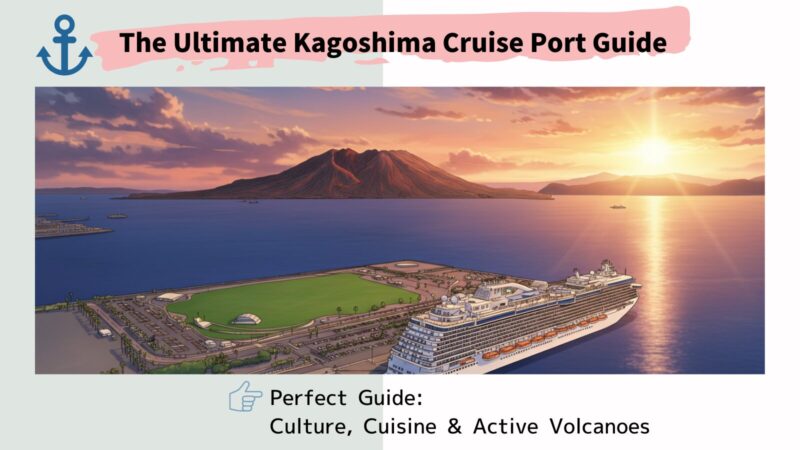
When your cruise ship pulls into a Japanese port, do any of these concerns sound familiar?
- You’ve only got half a day in Kagoshima – can you really hit all the highlights without feeling rushed?
- You didn’t come all this way to Japan just for another cookie-cutter tourist experience – you want something authentic, something real
- Between you and me, you’re wondering: is Kagoshima actually worth leaving the ship for, compared to Japan’s more famous ports?
Look, I get it. Trying to experience Kagoshima’s culture, cuisine, and that active volcano (yes, really!) in just half a day without a solid game plan? That’s a tall order.

Hi there! I’m Aoi, and I’ve spent years helping travelers like you make the most of their Japanese port stops through my site, Japan-cruise BLOG.
I’ve learned exactly what works and what doesn’t – and the key isn’t trying to see everything; it’s knowing what truly matters.
In this ultimate guide to Kagoshima’s cruise port, I’m going to walk you through exactly how to maximize that precious half day. We’ll cover the three things that make this port special: genuine cultural experiences, incredible food you won’t find anywhere else, and yes, an active volcano you can actually visit.
By the time you finish reading this, you’ll know exactly how to skip the tourist traps and zero in on the authentic experiences that other cruise passengers miss. Trust me, you’ll understand why Kagoshima deserves a spot at the top of your “ports worth exploring” list.
Ready to turn that half day into an unforgettable Japanese adventure? Let’s dive in.
Kagoshima Cruise Port Essentials: What You Need to Know When You Arrive
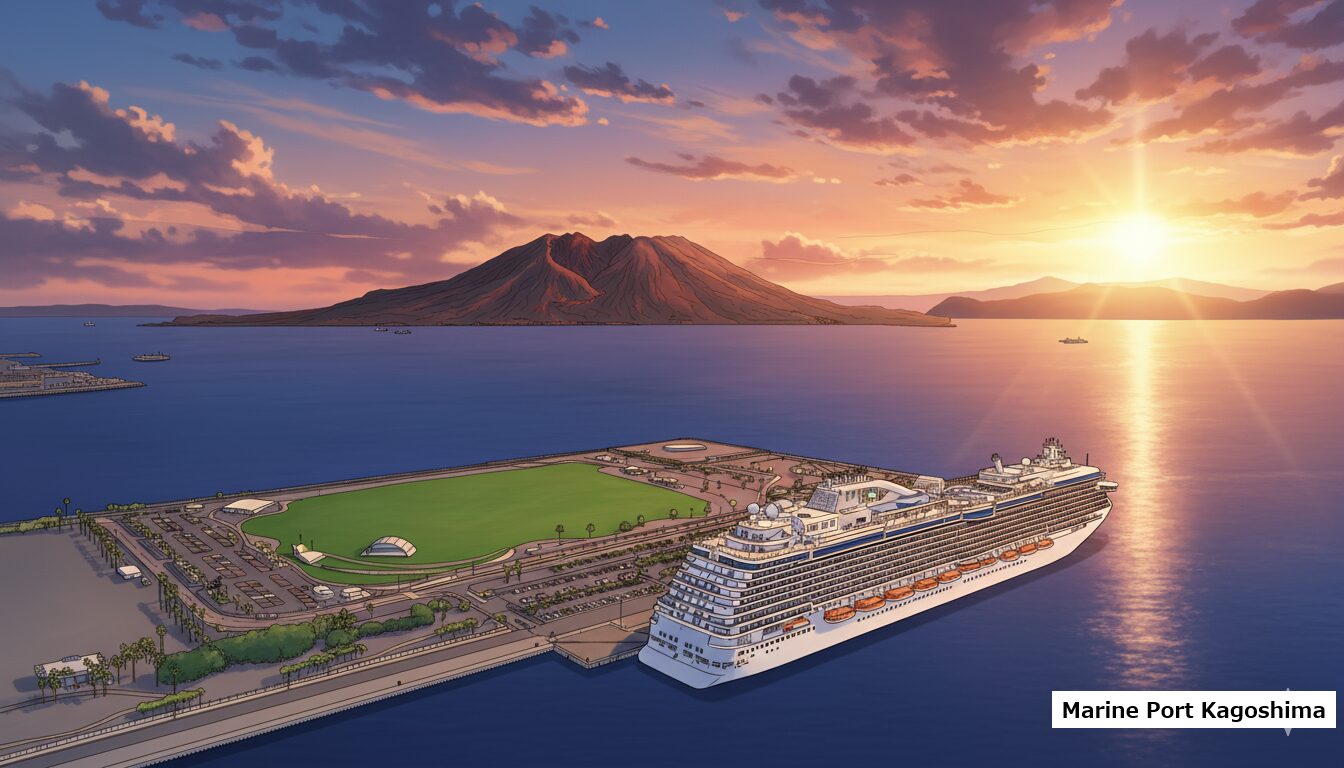
You know that moment when you step off the ship and think, “Okay, now what?” Well, Kagoshima’s cruise terminals are refreshingly straightforward and well-organized. Get the basics down now, and you won’t waste a single minute of your precious sightseeing time.
Marine Port Kagoshima handles the big ships – we’re talking vessels up to 168,000 gross tons at its 340-meter berth. In other words, pretty much any modern cruise ship can dock here comfortably.
Now, let’s talk about what you’ll find at the terminals. They’ve got all the practical stuff you need to start your day right.
Terminal Facilities & Amenities
Perfect photo opportunities with iconic volcano backdrop
Staying Connected: Wi-Fi & Mobile Coverage
Free Wi-Fi is available as soon as you step off the ship. Perfect for shooting a quick message home, downloading Google Maps for offline use, or getting that translation app ready. My advice? Do this right away. You might hit some spotty coverage once you’re exploring the city.
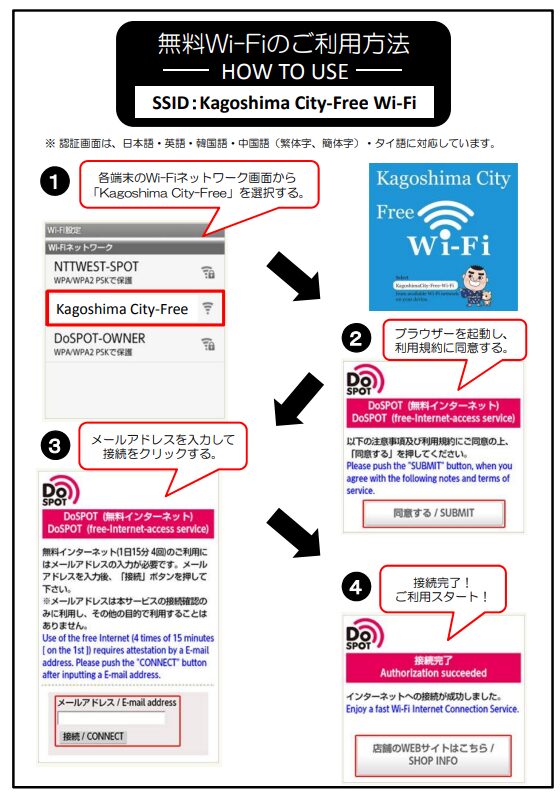
Getting Downtown: Your Transportation Options Explained

The first thing you’re probably thinking after docking is, “Okay, how do I actually get into the city?” Good news: Kagoshima’s transportation system is surprisingly traveler-friendly, with options for every budget and preference.
Whether you want free, flexible, or fast – you’ll be downtown within 30 minutes, no matter which option you choose.
Free Shuttle Buses: The Easiest Option
Want to keep things dead simple? The free shuttle bus is your answer. Literally just walk off the ship, hop on the bus, sit back, and get dropped in the city center. No cost, no navigation stress, no problem.
Shuttles run every 15 or 30 minutes, which means even if you miss one, you’re not waiting long. The ride takes 25-30 minutes depending on traffic.
Drop-off points include spots near Tenmonkan shopping district and the waterfront areas – basically where you want to be. The driver will announce stops, though not always in English, so keep Google Maps open to track where you are. Makes life easier.

My advice: Get on that shuttle early.
When thousands of passengers disembark from a big ship, these buses fill up fast.
And here’s the critical part – confirm the last shuttle time. Ask at the information desk or check the port handout they give you when you disembark. Missing that final shuttle means a taxi ride back, and that adds up.
Trams & Day Passes: Travel Like a Local
Now here’s where it gets interesting. If you want to experience authentic Kagoshima – to feel how locals actually move through their city – use the tram system.
Yes, it requires a bit more effort than the free shuttle. You’ll need to walk to the nearest tram stop from the port and figure out which line to take. But that extra effort pays off in a much richer experience.
From Marine Port to the nearest tram stop (Wakida), it’s a 20-30 minute walk – about 1.5 kilometers. The route is flat and well-signed, so you won’t get lost.
Honestly? Walking in the fresh morning air isn’t bad at all. Watching the city wake up, gradually immersing yourself in Kagoshima – it’s part of the experience.
That said, on a hot summer day or in the rain, the free shuttle might be the wiser call.
Now here’s the magic: buy a day pass (ichi-nichi jōsha-ken). For just ¥600 (about $4-5), you get unlimited rides on Kagoshima’s trams, city buses, and – this is the beautiful part – the Sakurajima ferry.
Think about it. A single tram ride costs ¥170, and the Sakurajima ferry round-trip is ¥380. So just by taking the tram twice and going to Sakurajima once, you’ve already broken even. Everything after that is free.
This is one of the best value-for-money options I recommend to travelers, hands down.
You can buy the day pass at ticket machines at major tram stops, directly from the driver, or at tourist information centers.
Using it is simple: just show your pass to the driver when you board. Enter through the front door, exit through the back – standard Japanese tram etiquette.
Trams run every 7-8 minutes and connect major tourist spots like Tenmonkan and the station nearest to Sengan-en. Announcements are mostly in Japanese, but many stops have English signage. Use Google Maps alongside, and you’ll be absolutely fine.
Riding the tram isn’t just transportation. You’ll sit alongside commuting salarymen, students heading to school, locals with shopping bags.
Looking out the window, you’ll see the Kagoshima that doesn’t make it into guidebooks – small shops, neighborhood cafes, residential streets. This is what I mean by “authentic experience.”
And honestly? The trams themselves are charming. The clatter of vintage cars, the brief stops at each station, the murmur of local conversations – all of this becomes part of your Kagoshima memory.
Taxis, City View Buses & Other Options
Taxis are convenient, no question. They’re especially good if you’re traveling as a group or want to go directly to a specific spot.
Expect to pay ¥1,000-1,500 (roughly $7-11) to downtown areas. For places like Sengan-en that are a bit further out, budget around ¥2,000-2,500.
But here’s the thing:
- Most taxi drivers don’t speak English. Have your destination written in Japanese or the address ready to show them
- Japanese taxis are among the cleanest and most courteous in the world, but they’re not cheap
- During peak times (especially when multiple ships dock simultaneously), finding a taxi can be tricky
Experiencing Authentic Kagoshima: Cultural Encounters That Matter

Alright, here’s where things get real. We’re done worrying about transportation. Now let’s talk about why Kagoshima is actually special – the cultural encounters you can only have here.
Kagoshima isn’t Kyoto. It’s not a famous tourist destination. And honestly? That’s exactly what makes it great. Here, you’ll find authentic Japan – unpolished, unpackaged, and utterly real.
Sakurajima: A Living Volcano You Can Actually Visit
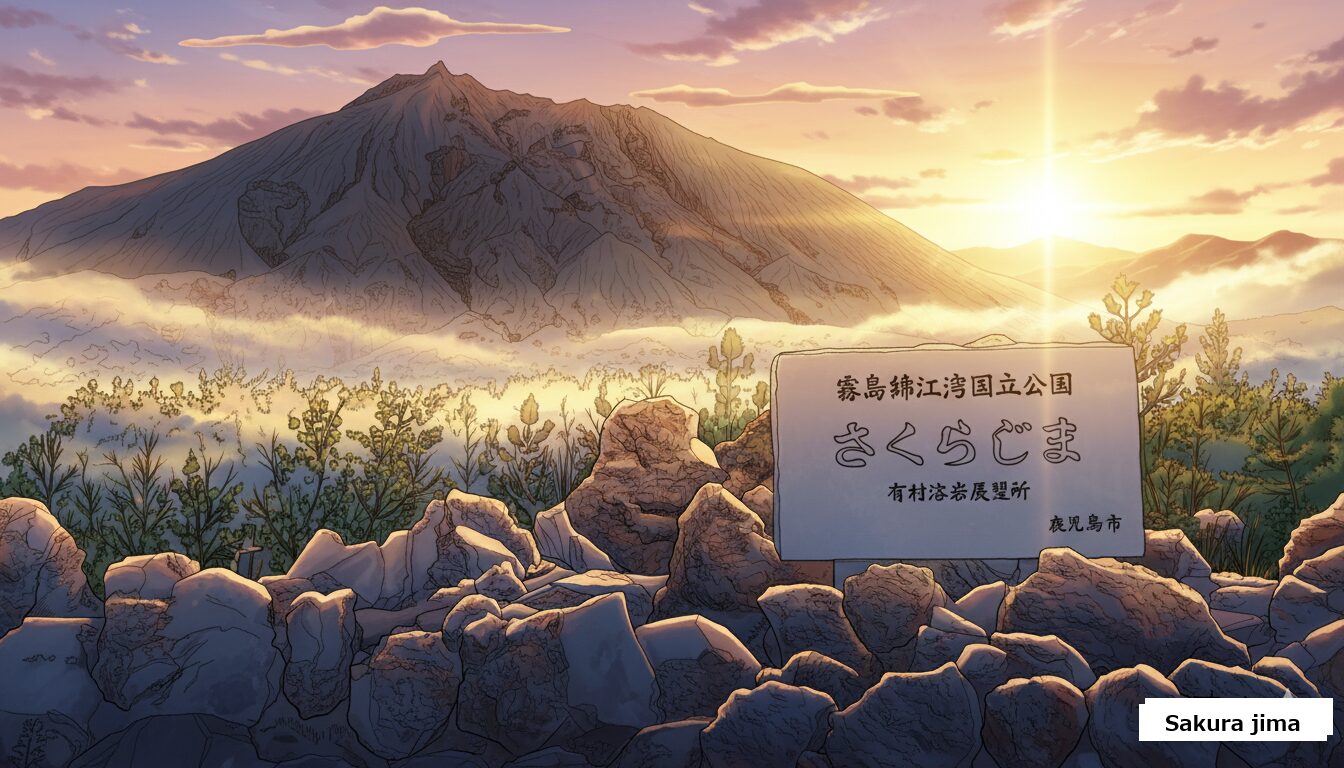
The first thing you’ll notice when you arrive in Kagoshima? Sakurajima. This volcano sits right there in the bay, quietly puffing smoke, watching over the city.
And the best part? You can actually go there. To an active volcano.
Getting to Sakurajima is surprisingly easy. It’s just a 15-minute ferry ride from Kagoshima Port. Cost? ¥190 (about $1.30) one way – cheaper than a coffee.
Ferries run every 15-30 minutes, so there’s basically no waiting. And if you bought that tram day pass (¥600) I mentioned earlier? The ferry’s included. No extra charge.
The boat ride itself is pretty great. Watching the volcano grow larger as you approach, the realization slowly hitting you: “I’m actually heading toward an active volcano.”
Once you’re on the island, you’ve got options.
Yunohira Observatory is the highest point accessible to the public. The view is stunning – Kinko Bay below, Kagoshima city in the distance, and literally a volcano beneath your feet. On clear days, you can watch smoke rising from really close up.
The Nagisa Lava Trail lets you walk on actual lava from past eruptions. The black, rocky landscape feels almost alien – like you’re on another planet.
And my personal favorite: the natural foot baths. Soaking your feet in volcanic hot springs while gazing at the ocean? Can’t think of a more luxurious way to relax. And it’s free.
But here’s what makes Sakurajima truly special – it’s not just the scenery.
For locals, this volcano isn’t a tourist attraction. It’s part of daily life. They’ve adapted to occasional ash falls, grateful for the hot springs and fertile soil the volcano provides.
This is one of the core concepts in Japanese culture – “kyōsei,” living in harmony with nature. Not fearing the volcano, but respecting it and coexisting with it. This mindset is crucial to understanding the Japanese worldview.
When you visit Sakurajima, you’re not just “seeing an active volcano.” You’re witnessing this deeper philosophy in action.
Sakura jima tips
Time needed: Budget 2-3 hours for the island. If you’re rushed, you can do the ferry round-trip plus the observatory in 1.5 hours.
About safety: Yes, Sakurajima is currently active (Alert Level 3). But don’t worry – tourist areas are completely safe, and they’d close immediately if there were any concerns. Thousands of tourists visited just last week without issues. Just stay out of the restricted 2km zone around the crater.
What to bring: Comfortable shoes, water, and – if ash is falling – clothes you don’t mind getting a bit dusty. Volcanic ash brushes off easily.
Sengan-en Garden: Walking Where Samurai Once Walked

Created in 1658 by the Shimazu clan, Sengan-en is a masterpiece of Japanese daimyo gardens. But this isn’t just a pretty garden. This is where samurai actually walked, where political decisions were made, where Japanese history moved.
And now you get to stand on those same stones.
One of Sengan-en’s most striking features is “shakkei” – borrowed scenery. This is a uniquely Japanese garden concept where distant landscapes (in this case, Sakurajima and Kinko Bay) are incorporated as intentional parts of the garden design.
Meaning: when you look at Sakurajima from the garden, it’s not accidental. Someone, over 350 years ago, calculated this exact view and designed around it. Every time you walk through this garden, you’re experiencing that intended beauty.
This level of refined aesthetic? That’s the depth of Japanese culture right there.
Inside the garden grounds, the Shoko Shuseikan Museum tells the story of the Shimazu family and how the Satsuma domain contributed to Japan’s modernization.
In the mid-1800s, as Japan’s isolation period ended, the Satsuma domain aggressively adopted Western technology. The museum displays early industrial machinery, weapons, and artifacts showing Western exchange.
History buffs could easily spend an hour here. Even if you’re not one, a quick 15-20 minute walk-through gives you context for why Kagoshima played such a crucial role in Japan’s modernization.
Guided tours: If possible, join an English-guided tour. Learning the historical context and the meaning behind each stone and tree placement completely changes the experience. Walking without a guide is still beautiful, but knowing the stories transforms what you see.
Sengan-en Garden tips
Time needed: 1-1.5 hours for the garden at a relaxed pace. Add another 30-45 minutes if you’re including the museum.
Admission: ¥1,000 (about $7) – honestly great value for what you get.
Best time: Early morning. Fewer tourists, quieter atmosphere, and you can appreciate the garden’s serenity.
When I visited, a woman in kimono was strolling through the garden. The scene looked timeless – like I’d stepped back centuries. Those moments where past and present intersect? That’s what you can only experience in Japan.
If you’re lucky, you might catch an actual tea ceremony in the tea house. You probably can’t participate, but even quietly observing gives you a sense of “wabi-sabi” – the Japanese aesthetic of finding beauty in imperfection and transience.
Tenmonkan District: Where Modern Japan Meets Tradition
Tenmonkan is Kagoshima’s biggest downtown district – a place for shopping, eating, and most importantly, witnessing everyday local life.
This isn’t a tourist zone created for visitors. This is a real commercial district where locals actually shop, eat, and meet friends. And that’s exactly why it’s interesting.
Walking through the covered arcades, you’ll see traditional wagashi (Japanese sweets) shops next to modern cafes. A 100-year-old establishment sits beside the latest fashion boutique.
This blend of old and new? That’s the essence of modern Japan. Not abandoning tradition, but letting it coexist with contemporary life. Walk through Tenmonkan, and you’ll see this philosophy reflected in the very streetscape.
Shopping: If you’re looking for souvenirs, this is your spot. Satsuma pottery, shochu, Kurobuta products, traditional sweets – it’s all here. Everything from large department stores to tiny specialty shops.
Eating: Tons of local restaurants. Some cater to tourists, but duck down a side street and you’ll find authentic izakayas and eateries filled with locals.
People-watching: This is my favorite. Grab a coffee, sit on an arcade bench, and just watch. Commuters, shopping families, students – this is real Kagoshima unfolding right in front of you.
Tenmonkan District tips
Time needed: 30 minutes for a quick walk-through. 1-2 hours if you’re shopping and eating leisurely.
Access: One of the free shuttle drop-off points. Or take the tram to “Tenmonkan-dori” stop.
Hours: Most shops open 10am-8pm. Restaurants and izakayas stay open later.
Language: English is limited, but gestures and smiles work. Google Translate makes it
Ibusuki Sand Bath: A Unique Wellness Experience
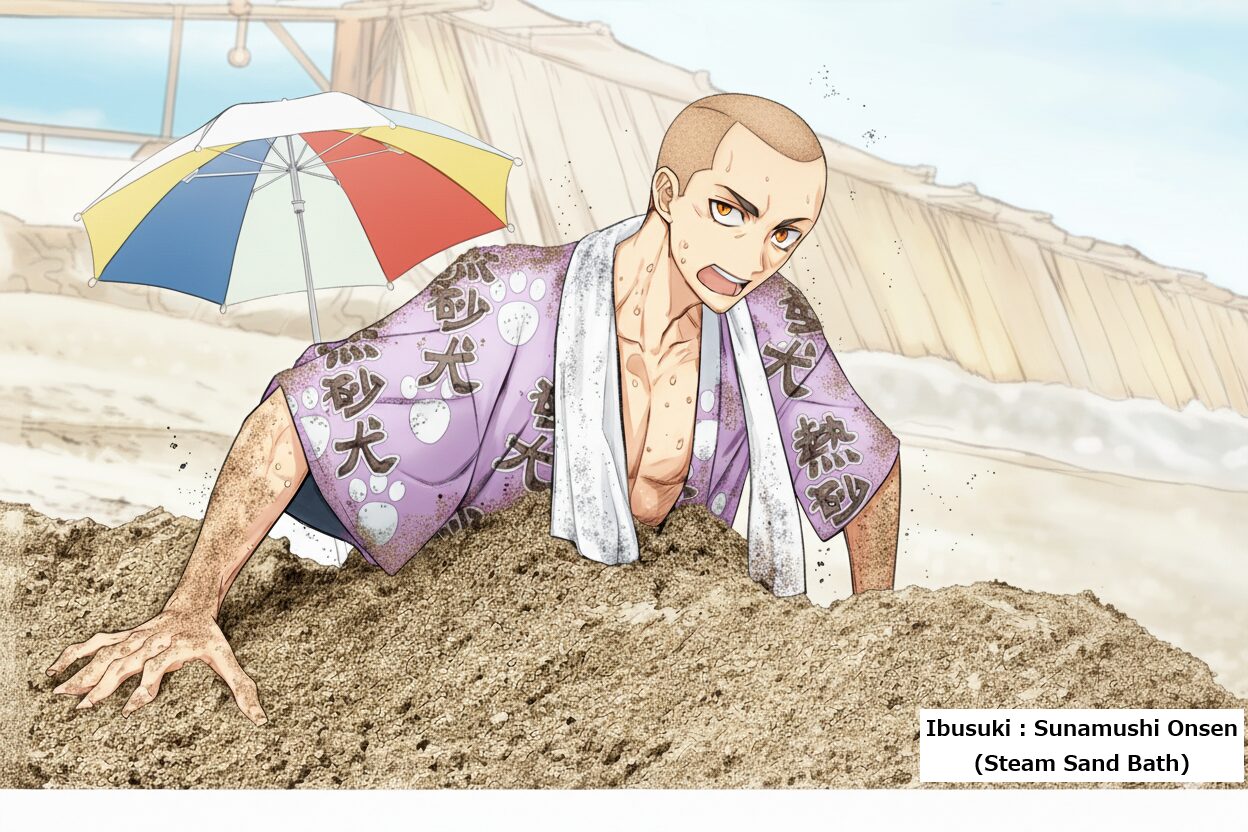
If you have extra time – and you’re looking for a truly unique Japanese experience – Ibusuki’s natural sand bath is worth considering.
This is a rare natural sand steaming bath found only in Ibusuki, even within Japan. It’s globally unusual. And honestly? It’s an unforgettable experience.
Ibusuki’s sand bath is a “living” spa experience using naturally occurring hot springs that emerge right on the beach.
The concept is simple, but the experience profound: wearing a yukata (light cotton robe), you lie on the beach sand. Staff cover your body with sand heated by underground hot springs. Only your face remains exposed – the rest of you is buried.
Then you just lie there, listening to wave sounds. After 10-20 minutes, the spring’s heat and the sand’s gentle pressure make sweat pour from deep within your body.
This isn’t just a sauna. This is an intimate dialogue with nature, created by geothermal heat, the ocean, and time.
1. Globally rare: Natural sand baths exist in only a few places worldwide. Ibusuki is the most famous and historic (over 300 years of history).
2. Health benefits: Japanese people have used these sand baths for centuries for circulation improvement, detoxification, and muscle pain relief. Scientific research confirms higher perspiration rates than regular hot springs.
3. Multi-sensory experience:
- Sound: Ocean waves
- Touch: Warm sand’s weight
- Smell: Salt and hot spring minerals
- Sight: Blue sky (or stars)
- Sensation: Heat rising from deep within
4. Cultural depth: This isn’t a tourist attraction created for visitors. This is authentic onsen culture that locals have used for generations.
Location: Ibusuki City (about 50km south of Kagoshima City)
Time required:
- 90 minutes each way from Kagoshima Port by car
- On-site stay: 1.5-2 hours (changing, sand bath, shower, rest)
- Minimum 4-5 hours round trip
Cost:
- Sand bath admission: About ¥1,000-1,500
- Round-trip taxi: About ¥20,000-25,000 (split among 4 people = ¥5,000-6,000 per person)
- Or rental car: ¥8,000-12,000/day
Hours: Typically 8:30am-9pm (last entry 8:30pm). Check specific facility.
Important notes:
- No swimsuit – you wear yukata (provided by facility)
- Bring towel or rent one (fee charged)
- Consult doctor if you have heart conditions or high blood pressure
- Avoid if pregnant
- Sand gets in hair but washes out easily in shower
Kagoshima’s Culinary Treasures: Food Experiences You’ll Never Forget
You can’t truly understand Kagoshima without experiencing its food culture.
This isn’t just “there’s good food here.” Kagoshima’s cuisine is the result of volcanic soil, warm climate, and surrounding seas – all creating a unique food culture over centuries.
And I’ll be honest: once you’ve tasted Kagoshima’s Kurobuta pork, other pork might never quite measure up again.
Kurobuta Pork: The Melt-in-Your-Mouth Delicacy
Kagoshima’s Kurobuta pork is among Japan’s most premium branded meats. But “branded” doesn’t capture what makes this pork truly extraordinary.
What sets Kurobuta apart is its marbling and that texture – it literally melts in your mouth. The fat is surprisingly sweet, never heavy. The meat is tender with deep, complex flavor.
This is the result of Kagoshima’s warm climate, special feed including sweet potatoes, and generations of breeding expertise.
There are several ways to experience Kurobuta, each offering a completely different experience.
How to eat Kurobuta pork
Tonkatsu (breaded pork cutlet): Crispy coating outside, juicy Kurobuta inside – this is Kagoshima style. That first bite reveals the contrast: crunchy exterior meeting soft, sweet meat inside. Served with special sauce or salt – personally, I recommend salt. It lets the pork’s natural flavor shine through.
Shabu-shabu (hot pot): Thinly sliced Kurobuta briefly swished through hot broth. This cooking method maximizes the pork’s delicate flavor and melt-in-your-mouth texture. Dip in ponzu citrus sauce or sesame sauce – both are incredible.
Kurobuta ramen: For something more casual, try Kurobuta ramen. Rich pork bone broth loaded with Kurobuta chashu. This is comfort food that locals love.
Where to eat Kurobuta pork
Tenmonkan district has numerous excellent Kurobuta restaurants. Some popular spots get fully booked, but here’s what helps:
About reservations: Famous places often fill up, but try lunch hours (11:30am-2pm) or early dinner (5-6pm) – you might get in without reservations.
Price range: Tonkatsu sets run ¥1,500-3,000 (about $10-20). Shabu-shabu is higher, around ¥3,000-6,000 (roughly $20-40). Reasonable prices for an authentic experience at this level.
Ordering tip: Make sure the menu specifies “Kagoshima Kurobuta” or “Kurobuta.” Just “pork” might not be the branded Kurobuta.
Shochu: Tasting the Spirit of Satsuma
Imo shochu is a distilled spirit made from sweet potatoes, and it’s the soul of Kagoshima (once known as Satsuma domain).
It’s typically 25-30% alcohol – similar to whiskey or vodka in strength, but completely different in flavor. Imo shochu has a distinctive earthy, slightly sweet character that’s polarizing – you’ll either love it or need time to appreciate it.
Honestly? Your first reaction might be “whoa.” But drink it with locals. Listen to their passion for shochu, their heated debates about favorite brands – you’ll understand this isn’t just alcohol. It’s culture in liquid form.
There are several ways to drink shochu:
Straight (room temperature): The purist’s way. You’ll taste the full flavor profile, but it’s strong. Sip slowly from a small glass.
On the rocks: Shochu over ice. The cold mellows the strong flavors, making it more approachable. This is what I recommend for beginners.
Mizuwari (mixed with water): Shochu diluted with water, typically 60% shochu to 40% water. This is the most common way and works great with meals.
Oyuwari (mixed with hot water): Shochu with hot water, especially popular in winter. The heat brings out different aromatic notes – it’s a completely different experience.
Shochu tips:
Imo shochu makes an excellent souvenir. You can buy it at liquor stores in Tenmonkan or at the airport.
- Beginner-friendly: “Shiranami” or “Satsuma Shiranami” – relatively mild and accessible
- Intermediate: “Kuro Kirishima” – well-balanced with characteristic imo shochu flavor
- Advanced: “Moriizo” or “Maou” – rare premium bottles that are hard to find
Prices range from ¥1,000 to over ¥10,000. The ¥2,000-3,000 range offers quality bottles.
Heads up: It’s liquid, so it’s heavy. If buying multiple bottles, consider the weight for getting back to your ship.
Meaningful Souvenirs: Taking Kagoshima Home With You
Let’s talk about souvenirs that matter: from artisan crafts showcasing generations of skill to delicious edibles you’ll actually use and enjoy.
Imo shochu
I already covered this in the food section, but imo shochu is one of the best souvenirs.
Why it’s excellent:
- You’ll actually use it (and enjoy it)
- It has a story – every brand has history and personality
- Quality bottles at relatively reasonable prices
- Share it with friends and family while telling your Kagoshima stories
Buying tip: Get multiple smaller bottles (300ml or 500ml) rather than one large bottle. You can try different brands and they’re easier to give as gifts.
Packaging: Most liquor stores will wrap bottles beautifully for gifts. For extra, they’ll put them in wooden boxes – perfect for special gifts.
Satsuma-yaki
Satsuma-yaki is Kagoshima’s traditional pottery with over 400 years of history. It began in the late 16th century when Korean potters were brought to the region and developed a distinctive style.
There are two main types:
Shiro Satsuma (White Satsuma): Cream-colored pottery with delicate gold leaf decorations. Originally made exclusively for feudal lords and nobility. It captivated Westerners at the 1867 Paris Exposition and became internationally known as “Satsuma ware.” These are art pieces with corresponding prices.
Kuro Satsuma (Black Satsuma): More rustic and robust, dark-toned pottery. Made for everyday use, especially for serving shochu in tokkuri (sake flasks) and cups. Practical yet characterful.
Satsuma-age
Satsuma-age is traditional Kagoshima fish cake – minced fish that’s deep-fried (though actually more steamed than fried, so surprisingly healthy).
They come in many varieties – plain, with vegetables, with cheese, with spicy cod roe. Eat them as-is, warm them up, or use them in cooking.
Why they’re great souvenirs:
- Shelf-stable for several days (longer if vacuum-packed)
- Lightweight and easy to pack
- Unusual but genuinely delicious
- ¥1,000-2,000 gets you plenty
Easy to find in Tenmonkan or at the ferry port. Many shops offer samples, so you can taste before buying.
Making the Most of Your Half Day: Practical Tips That Work
Sample Half-Day Itinerary
First things first: you cannot see everything in half a day. And that’s okay.
Release yourself from the pressure of “I must see it all.” Instead, focus on deeply enjoying 2-3 core experiences. That’ll leave you way more satisfied than rushing through five places superficially.
Here are sample itineraries for three different types of travelers.
For: People seeking authentic experiences who want both nature and history
For: Food-focused travelers who prefer a more relaxed pace
For: Very time-limited travelers who want to hit only major spots efficiently
These are templates. Adjust based on your interests and ship departure time.
Want to skip Sakurajima for more Sengan-en time? That’s perfectly valid. Need more shopping time? Shorten lunch and allocate more for shopping. Want to feel more local atmosphere? Add “buffer time” to any itinerary for serendipitous encounters.
The point isn’t following a rigid plan – it’s using it as a guide.
What to Bring
- 1. Comfortable walking shoes: Non-negotiable. Sengan-en’s gravel paths, Sakurajima’s lava rocks, Tenmonkan’s cobblestones – you’ll be walking quite a bit. Choose broken-in shoes, not new ones. Practical over fashionable.
- 2. Japanese yen in cash: No currency exchange at the port. Exchange on ship beforehand or hit an ATM first thing downtown. As a guideline, ¥10,000-15,000 per person (about $70-100) comfortably covers meals, transport, and souvenirs.
- 3. Smartphone (fully charged): Google Maps, Google Translate, camera – all in one device. Make sure battery is topped up. Portable charger is even better.
- 4. Small bag or backpack: For souvenirs, shed layers, purchased drinks. Having both hands free makes taking photos and moving around easier.
Timing is Everything: Getting Back to Your Ship on Time
Remember this above all else: Your ship will not wait for you.
No matter how much fun you’re having, no matter how delicious that meal is, the ship leaves on schedule. Getting left behind is an expensive, complicated nightmare.
So time management is non-negotiable. This isn’t about killing the fun – it’s about enjoying yourself with peace of mind.
Three times you must confirm:
- 1. All Aboard Time: This is when you must be back on the ship. Usually 30-60 minutes before departure. This is your deadline. Not the departure time.
- 2. Ship Departure Time: When the ship actually leaves port. By this time, you need to already be onboard.
- 3. Last Shuttle Time: Final free shuttle from downtown to port. Miss this, and you’re taking a taxi back.
These times are in the ship’s daily newsletter, cabin TV, or port handout given at disembarkation. Take a photo or write them down.
Frequently Asked Questions About Kagoshima Cruise Port
We’ve covered a lot, but you probably still have some questions. Here are the most common questions travelers ask – and the answers you need to know before you go.
These are real questions from actual cruise passengers, asked repeatedly. If you’re wondering the same things, you’re not alone.
Is Sakurajima Still Active and Safe to Visit?
Short answer: Yes, Sakurajima is currently active. And yes, it’s safe to visit.
Longer explanation:
Sakurajima is indeed an active volcano with regular eruptions. It typically sits at Alert Level 2-3 (on a scale of 5), with occasional small eruptions and ash falls.
But here’s the thing: Locals have lived with Sakurajima for generations. Thousands of people live and work on the island daily. Tourist areas are completely safe, and authorities monitor volcanic activity 24/7.
If there were danger, tourist areas would close immediately. In fact, thousands of tourists visited last week, last month, without issues.
Safety guidelines:
- Stay out of the restricted 2km zone around the crater
- Stick to designated tourist areas (Yunohira Observatory, Nagisa Lava Trail, etc.)
- If ash is falling, wear a mask or cover your mouth with a handkerchief
- Follow any local instructions or warnings
Realistically: You might see an eruption while there, but it’ll be distant – “a bit more smoke than usual.” Lava flowing toward you or needing to evacuate? Virtually impossible.
Actually, the fact that Sakurajima is active is what makes visiting special. Not many places on Earth let you feel the planet’s aliveness this intimately.
Are There Medical Facilities Near the Port?
Short answer: The terminal itself has no medical facilities, but nearby hospitals are easily accessible in emergencies.
Longer explanation:
Kagoshima Tokushukai Hospital is the closest major hospital to the port, offering 24-hour emergency services. About 10-15 minutes by taxi, costing around ¥1,500-2,000.
Ship-based care: Most cruise ships have medical facilities onboard. For minor issues (headaches, small injuries, upset stomach), consult the ship’s medical staff first.
In emergencies:
- Japan’s emergency number is 119 (ambulance)
- Ask terminal staff for help – they’ll call an ambulance
- Major hotels have English-speaking staff who can help direct you to medical facilities
Important preparations:
- Bring your travel insurance documentation. Japanese healthcare is high-quality but expensive for foreigners
- If you have prescriptions, bring adequate supplies
- Having a medication list in both English and Japanese (if possible) helps
Language barrier: Hospital staff might speak some English, but medical interpreters may be needed. Google Translate helps, but for serious situations, contact your ship’s staff for support.
Good news: Japan’s healthcare system is world-class. If you need care, you’ll receive excellent treatment.
What’s the Best Time to Visit Kagoshima?
Short answer: Spring (March-May) and fall (September-November) are ideal, but each season has its charms.
Longer explanation:
Spring (March-May) – Peak Season:
- Temperature: 15-25°C (59-77°F)
- Weather: Comfortable and fresh, mostly clear days
- Highlights: Cherry blossoms (late March-early April), vibrant new greenery
- Note: Golden Week (late April-early May) gets crowded
Summer (June-August):
- Temperature: 25-35°C (77-95°F)
- Weather: Hot and humid. June is rainy season
- Highlights: Summer festivals, energetic atmosphere
- Note: September has typhoon risk. Very hot – hydration essential
- Tip: Start sightseeing early morning to beat the heat
Fall (September-November) – Peak Season:
- Temperature: 18-28°C (64-82°F)
- Weather: Comfortable and dry, perfect for sightseeing
- Highlights: Autumn foliage (November), Ohara Festival (November 2-3)
- Note: September still has typhoon possibility
Winter (December-February):
- Temperature: 5-15°C (41-59°F)
- Weather: Cool but snow is rare. Relatively dry
- Highlights: Fewer tourists, hot springs are best this season
- Note: Some tourist facilities may have shorter hours
My recommendation: If you can choose, late March through mid-May or October through mid-November. Weather is perfect, temperatures ideal for exploring. But honestly, Kagoshima has something enjoyable in every season.
Is There Luggage Storage Available?
Short answer: Marine Port terminal itself has no lockers, but several options exist.
Longer explanation:
Best option – leave it on the ship: Honestly, this is the simplest solution. Most cruise passengers disembark with just a small day bag, leaving large luggage in their cabin.
What you really need for half-day sightseeing:
- Wallet and cash
- Smartphone
- Camera (if phone camera isn’t enough)
- Light jacket
- Water bottle
All this fits in a small backpack or shoulder bag.
If you’re arriving early (pre-cruise):
1. Coin lockers:
- Dolphin Port (near cruise terminal) has coin lockers
- Kagoshima-Chuo Station has many lockers (about 10 min taxi from port)
- Cost: Small ¥300-400, medium ¥500-600, large ¥700-800/day
- Size limits – large suitcases might not fit
2. Luggage storage services (like LuggageHero):
- Partner shops throughout the city (cafes, stores) hold luggage
- Requires pre-booking via app
- Cost: About ¥800-1,000 per item/day
- Can handle large luggage
3. Hotel luggage hold: If staying at a Kagoshima hotel before/after cruise, most hotels hold luggage before check-in/after check-out (usually free).
Practical advice: For most cruise passengers, luggage storage isn’t an issue. Leave it on ship, disembark with just a day bag. If you have special circumstances (like traveling Japan pre/post-cruise) requiring storage, Kagoshima-Chuo Station lockers are the most reliable option.
How Much Should I Budget for Half a Day?
Summary:Kagoshima is Waiting for You

When I first pulled into Kagoshima, I wasn’t expecting much. But somewhere between riding that ferry to Sakurajima, eating Kurobuta pork at a local izakaya, and walking through Sengan-en gardens, something shifted. This wasn’t just sightseeing – this was an actual encounter with real Japan.
Only got half a day? Yes, it’s short. But the moments that stick with you don’t measure in hours. The five minutes watching smoke rise from Sakurajima. The second when Kurobuta melts on your tongue. Standing where samurai once stood. That “Kanpai!” smile from a local. These measure in memory.
Now go. Kagoshima is waiting.
Looking to book shore excursions for your cruise? These are the services I recommend:
- japanshoreexcursions.com
- shoreexcursions.asia
- vietnamshoreexcursions.asia
- chinashoreexcursion.com
- globalshoreexcursions.com

If you’re curious to learn more about what makes these Japan-based cruises so special, I’ve put together detailed articles on each one—feel free to check them out!
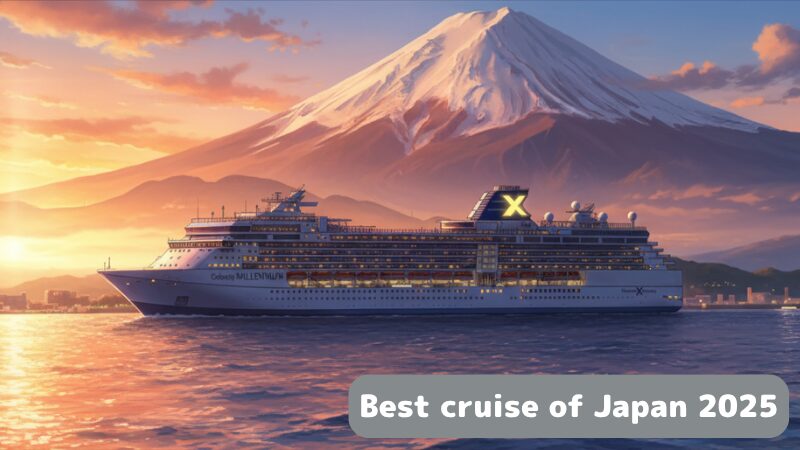 The Best Japan Cruises 2026: An Insider's Guide to Unforgettable Cultural Experiences
If you're planning a cruise from Japan, you might be wondering: Want to experience authentic Japanese culture and festivals—but not sure where to start? Wondering when's the best time to cruise Japan? Curious if you'll actually get to explore those historic sites you've been dreaming about? If you try looking at cruise line websites, you'll find that very few of…
The Best Japan Cruises 2026: An Insider's Guide to Unforgettable Cultural Experiences
If you're planning a cruise from Japan, you might be wondering: Want to experience authentic Japanese culture and festivals—but not sure where to start? Wondering when's the best time to cruise Japan? Curious if you'll actually get to explore those historic sites you've been dreaming about? If you try looking at cruise line websites, you'll find that very few of…
 The Ultimate Guide to Cruises Around Japan: Luxury, Culture, and Everything in Between
If you're planning a cruise from Japan, you might be wondering: Hokkaido's nature, Kyoto's temples, Kyushu's hot springs—I want it all, but how? Japan has so much to see, but who wants to spend their vacation packing and unpacking at every stop? "I want to relax AND see Japan's best. Is that too much to ask? You're not alone—and I'm…
The Ultimate Guide to Cruises Around Japan: Luxury, Culture, and Everything in Between
If you're planning a cruise from Japan, you might be wondering: Hokkaido's nature, Kyoto's temples, Kyushu's hot springs—I want it all, but how? Japan has so much to see, but who wants to spend their vacation packing and unpacking at every stop? "I want to relax AND see Japan's best. Is that too much to ask? You're not alone—and I'm…
 Diamond Princess Japan 2026: Compare Cruise Plans, Prices & Itineraries
If you're planning a cruise from Japan, you might be wondering: I keep hearing about Princess Cruises for Japan—but is it really worth it? I only have limited vacation time—which itinerary will let me see the most important parts of Japan? I'm worried about the language barrier and cultural differences—will a cruise make Japan more accessible for me? If any…
Diamond Princess Japan 2026: Compare Cruise Plans, Prices & Itineraries
If you're planning a cruise from Japan, you might be wondering: I keep hearing about Princess Cruises for Japan—but is it really worth it? I only have limited vacation time—which itinerary will let me see the most important parts of Japan? I'm worried about the language barrier and cultural differences—will a cruise make Japan more accessible for me? If any…
 Celebrity Millennium Japan 2026: Compare Cruise Plans, Prices & Itineraries
If you're planning a cruise from Japan, you might be wondering: I keep hearing about Celebrity Cruises for Japan—but is it really worth it? I only have limited vacation time—which itinerary will let me see the most important parts of Japan? I'm worried about the language barrier and cultural differences—will a cruise make Japan more accessible for me? If any…
Celebrity Millennium Japan 2026: Compare Cruise Plans, Prices & Itineraries
If you're planning a cruise from Japan, you might be wondering: I keep hearing about Celebrity Cruises for Japan—but is it really worth it? I only have limited vacation time—which itinerary will let me see the most important parts of Japan? I'm worried about the language barrier and cultural differences—will a cruise make Japan more accessible for me? If any…
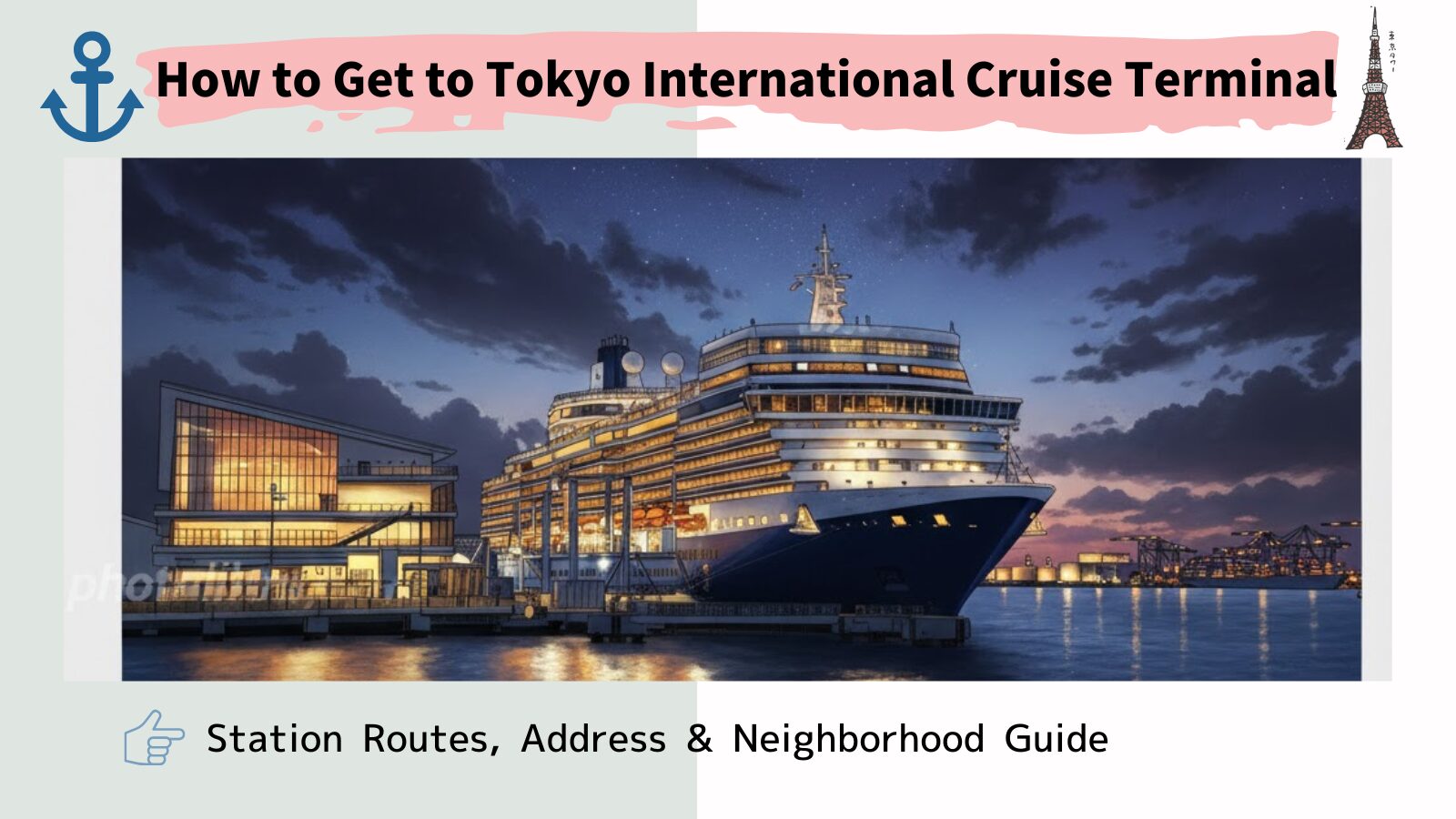 Your Complete Guide to Tokyo International Cruise Terminal: Address, Station Access & What's Nearby
If you're planning a cruise from Tokyo, you might be wondering: How do I navigate a foreign city with a language barrier? What's the easiest way to find the cruise terminal without getting lost? Where can I discover memorable spots near the terminal to make my visit truly special? You're not alone—and I'm here to help. Tokyo International Cruise Terminal…
Your Complete Guide to Tokyo International Cruise Terminal: Address, Station Access & What's Nearby
If you're planning a cruise from Tokyo, you might be wondering: How do I navigate a foreign city with a language barrier? What's the easiest way to find the cruise terminal without getting lost? Where can I discover memorable spots near the terminal to make my visit truly special? You're not alone—and I'm here to help. Tokyo International Cruise Terminal…
I’d love to help you experience Japan in this unique way. Let’s make it happen together!

I’ll keep sharing insider tips and updates about cruising in Japan, so please stop by again soon! I’m here to help you discover the best of Japan. Let’s explore together!
Happy cruising!– , Cruise Aoi